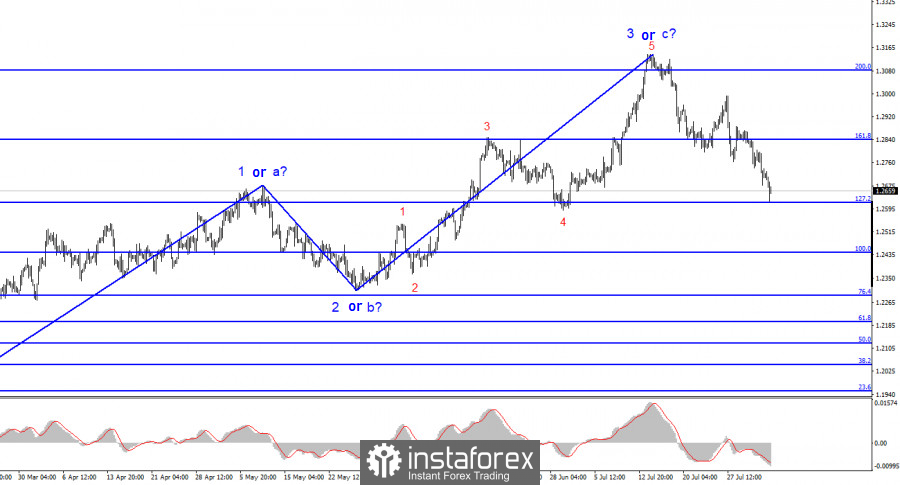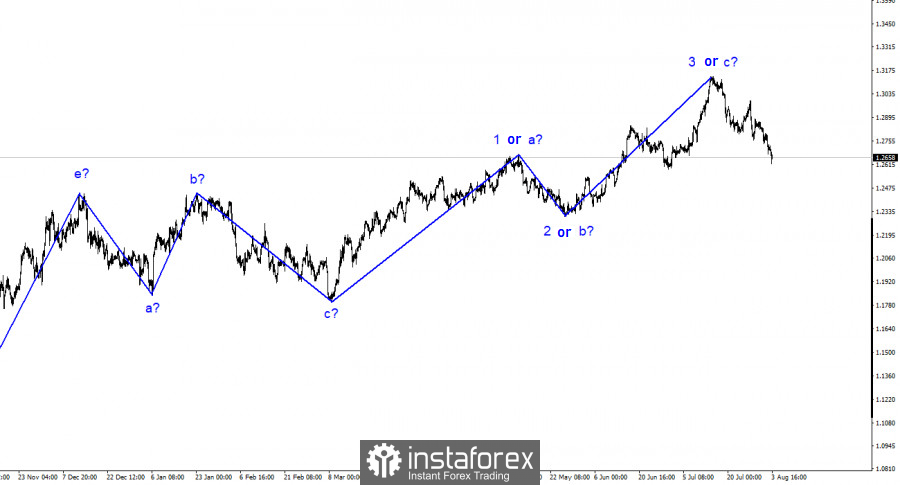
The wave analysis for GBP/USD remains relatively straightforward and clear. Currently, either the construction of the upward wave 3 has been completed, or a presumed new downward trend segment, possibly the fourth wave, has started. There are no reasons for the British currency to resume its upward movement; various reports and events support this. However, the wave analysis has evolved into a more intricate structure, and wave 3 has taken a more prolonged form than anticipated by many analysts a couple of months ago. The ascending trend segment could take on a five-wave pattern if the market discovers new reasons for long-term buying.
The wave analysis for the British pound appears much simpler and more convincing than the euro. Regardless, I expect the downward wave to continue, which started almost exactly on schedule. Even if this is the fourth wave within the ascending wave set, it should be significantly extended or distinctly three-wave. Three waves are already evident within it, and the current week's news background is crucial. Will the British pound find reasons for a new increase?
The market anticipated, waited, and ended up disappointed.
On Thursday, the exchange rate of the pound/dollar pair decreased by an additional 40 basis points, with the range of movements at around 50 basis points at the time of writing this article. I expected more - more from the pair, the market, and the Bank of England. However, this time, the British regulator did not surprise the public and raised the interest rate as the market desired. The rate now stands at 5.25%, increasing for the 14th consecutive meeting, and the Bank of England is nearing its final tightening phase.
Frankly, few people expected a 50-point rate increase from the Bank of England last month. The decision came as a surprise, as the regulator had previously refrained from such a move. This suggests that it either did not expect to raise the rate so significantly or did not anticipate inflation to slow down as much. In both cases, it was an unforeseen event.
During the current meeting, eight out of nine members of the Monetary Policy Committee voted in favor of the rate hike, with only one member opting to keep it at its previous value. In previous meetings, the vote was typically 7 to 2. We will find out later which policymaker sided with the "hawks" at the very end of the monetary policy tightening process. Nevertheless, this vote will not impact the Bank of England's future rate plans. Regardless of the number of policymakers voting for an increase, the British regulator is approaching its peak, a sentiment that the market perceives, leading to decreased demand for the pound.

In conclusion, the wave pattern for the pound/dollar pair points to a decline. As the attempt to break through the 1.3084 level (from top to bottom) was successful, my readers could have opened sales, as I mentioned in my recent reviews. The target is the 1.2618 level, which has already been achieved. There is a risk that the current downward wave may complete if it is indeed the fourth wave. In such a scenario, a new upward movement within wave 5 will likely commence from the current levels. However, this is not the most likely scenario, and a successful attempt to break 1.2618 will indicate the market's willingness to decrease the demand for the British pound further.
On a larger wave scale, the pattern is similar to the euro/dollar pair, but some differences remain. The downward corrective segment of the trend is complete, and the construction of a new upward segment is ongoing, which may have already concluded or might adopt a full-fledged five-wave form.
 English
English 
 Русский
Русский Bahasa Indonesia
Bahasa Indonesia Bahasa Malay
Bahasa Malay ไทย
ไทย Español
Español Deutsch
Deutsch Български
Български Français
Français Tiếng Việt
Tiếng Việt 中文
中文 বাংলা
বাংলা हिन्दी
हिन्दी Čeština
Čeština Українська
Українська Română
Română

